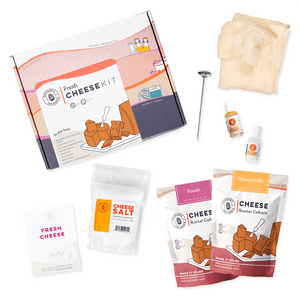
Manchego is a Spanish cheese from the La Mancha region. It was originally made from sheep milk, but can be made from other milks. Some people will tell you that the only real Manchego cheese is those wheels which are aged in the caves of its originating climate, but this is up to personal opinion. Manchego is traditionally rich and subtle, with four different stages of aging. First, a white, fresh Manchegofresco is aged for less than a week and is not technically considered a true Manchego by cheese aficionados, but is delicious all the same. Coming up next, Manchegocurado, aged for up to 12 weeks, is a semi-cured, partially solid cheese with a mild, nutty piquancy and a smooth, creamy texture. Curado is good for melting, and has just a hint of yellowish color. Next, Manchegoviejois aged for up to 12 months, and is a thoroughly solid cheese that has developed a rich yellow color. Viejo has an increased complexity, with a sharper kick to it and a slightly peppery edge. This cheese has matured enough to take center stage in any cuisine, sliced, shredded, crumbled, or melted. Finally, manchegoaceite is aged coated in olive oil for 1 year, and is the strongest, most developed of any of the stages. It is very hard, deeply yellow, and its taste is only for the strongest cheese connoisseurs.
20 minutes
50 minutes
6
INGREDIENTS AND EQUIPMENT AVAILABLE AT CULTURES FOR HEALTH
Fresh Cheese Making Kit

Fresh Cheese Making Kit
$45.99
Our most comprehensive choice, the Fresh Cheese Kit contains two starter cultures and supplies to make five different varieties of soft cheese - feta, cottage cheese, cream cheese, fromage blanc, and traditional quark. Kit contains a Mesophilic Cheese Culture, a Fresh Cheese Culture, calcium chloride, vegetable rennet, cheese salt, butter muslin, a thermometer, and an instruction and recipe card.
Packaging and Equipment in the kit may appear different than pictured.
INGREDIENTS:
- 2 gallons whole cow milk
- 1/2 packet direct-set mesophilic starter
- 1/2 packet direct-set thermophilic starter
- 1/4 tsp. lipase powder diluted in 1/4 cup of cool, unchlorinated water and allowed to dissolve for at least 15 minutes
- 1/2 tsp. liquid rennet dissolved in 1/4 cup cool, unchlorinated water
- Sea salt and purified water for brine
INSTRUCTIONS:
- Heat the milk to 86°F in a water bath.
- Combine both starters in a small plastic measuring cup and sprinkle them over the surface of the milk. Allow the starter to rehydrate on the surface of the milk for 1 full minute before stirring it in with a cheese spoon.
- Stir in the starter using smooth, long, up-and-down strokes for 1 full minute, then cover the milk and allow it to ripen for 45 minutes, maintaining the temperature at 86°F throughout.
- Add the diluted lipase and stir it in using the same methods as used for incorporating the starter. Add the rennet by pouring it through the cheese spoon and into the milk. Stir using up-and-down motions for 1 minute.
- Cover the milk and let it set undisturbed for 30 minutes or until it gives a clean break.
- Cut the curd into 1/2-inch cubes and re-cover to rest for 5 more minutes.
- Using a clean stainless steel whisk, stir the curds to cut them into rice-sized pieces. This may take a long time, up to 30 minutes.
- Slowly heat the curds to 104°F, bringing the temperature up by 2 degrees every 5 minutes. Stir the curds to keep them from matting while you are heating them up.
- Once the curds have reached the correct temperature, let them sit undisturbed for 5 minutes, then pour off all the whey.
- Line a two-lb. cheese mold with damp cheesecloth and ladle the hot curds into it. Replace the follower and press at 15 lbs. of pressure for 15 minutes.
- Take the cheese out of the mold, unwrap it, flip it over, re-wrap it in the cheesecloth and put it back into the mold. Press again at 15 lbs. of pressure for 15 minutes.
- Remove, undress, flip, redress, and replace the cheese. Press once more at 15 lbs. for 15 minutes.
- Remove, undress, flip, redress, and replace the cheese. Press this time at 30 lbs. for 6 hours.
- Make a saturated brine and chill it. Place the cheese and the brine into a plastic or other non-reactive bowl and place it, covered, into the refrigerator for 6 hours.
-
Remove the cheese from the brine, pat it dry with paper towels, and air-dry it for a few days. Age at 55°F for any length of time, depending on the desired strength. The cheese can be covered in olive oil to prevent it from becoming dried out.
















